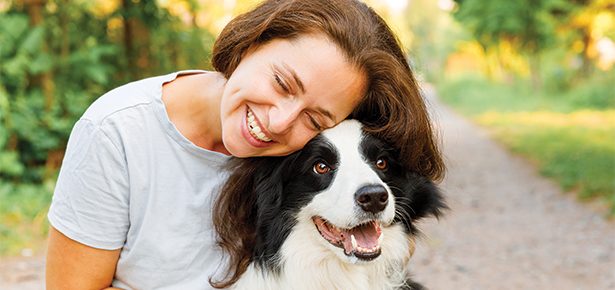

The Importance of Positivity
The power of positive training in dog behaviour and beyond
 I’m sitting across from a husband and wife that are on the verge of divorce. They’ve started arguing again and seem to have forgotten that I’m in the room. I’ve been in their home only 30 minutes and already I’ve been exposed to the most intimate details of their lives, the wife accusing her husband of wanting to be with the dog more than he wants to be with her and the husband telling her how ridiculous she sounds. He loves his dog even though the dog has bitten his wife on a number of occasions, and he refuses to give in to her demands to give the dog away.
I’m sitting across from a husband and wife that are on the verge of divorce. They’ve started arguing again and seem to have forgotten that I’m in the room. I’ve been in their home only 30 minutes and already I’ve been exposed to the most intimate details of their lives, the wife accusing her husband of wanting to be with the dog more than he wants to be with her and the husband telling her how ridiculous she sounds. He loves his dog even though the dog has bitten his wife on a number of occasions, and he refuses to give in to her demands to give the dog away.
In situations like this, it’s hard for me not to become emotionally embroiled, but I have to think clearly and logically about what the next steps should be. I am not a trained marriage counselor, but have learned that being a good dog trainer means sometimes having to deal with difficult human situations in addition to providing solutions to complex canine behavioural issues. The two go hand in hand, as many of the canine issues I see have been caused or greatly influenced by the people dogs live with or the environment in which they live.
Early in my work I discovered that just listening to people talk about any given situation is a big part of the human rehabilitation process—talking about feelings provides profound relief. Helping people communicate successfully—which frequently means framing problems positively or without blame—enables them to air out differences and create solutions not just for the humans in the household but also for the dogs.
Positivity is powerful on so many levels. It improves communication, facilitates understanding, and promotes patience. Endeavouring to understand how a family member feels or why a dog is misbehaving lets you address the root cause of the feeling/behaviour and the empathy this understanding gives you helps to tackle the problem in a positive manner, giving both dog and person a greater chance of success. This is why I call my teaching methods positive training and why my company is called Positively; a positive approach yields results. It’s not always easy, but thinking and teaching positively greatly enhances learning and strengthens the human/animal bond.
The use of positive methods when teaching a dog has been universally endorsed by the behavioural scientific community at large as the most effective, long-lasting, and humane dog training method, not to mention the safest. Basically, with positive reinforcement—which is essentially rewarding a behaviour you like—there’s a better chance of that behaviour being repeated. Not that it’s all treats or praise. Positive training still utilizes “negative” punishment (the removal or withholding of something the dog wants like food, attention, toys, or human contact for a short period of time) or vocal interrupters to redirect negative behaviour to a wanted behaviour. It’s all about guiding a dog into making the right choices.
Traditional (old school) trainers often argue that positive training shows weakness and a lack of leadership, but the truth is that the most respected and successful leaders are able to effect change without the use of force. Punitive trainers also believe that positive training only works on small dogs with minor behavioural issues and that a heavier hand is needed with large, unruly dogs or those dogs that are highly driven, such as working dogs. But in reality, positive principles are by far the most effective way to teach all kinds of dogs, including those that suffer from severe anxiety or aggression.
Contrary to what many people have been led to believe, most dogs are not trying to be dominant when they misbehave. The truth is that dogs are not on a quest for world domination. They are not socialized wolves who are constantly striving to be “top dog” over us, and they are not hard-wired to try and control every situation they are in. Unlike what traditional training ideologies and much modern media would have people believe, most canine behaviour problems stem from insecurity and/or a desire to seek and maintain safety and comfort, not from a desire to establish higher rank and be the “alpha.” Therefore, teaching dogs “who the boss is” by forcing them into some mythical state called “calm submission” is precisely the opposite of what dogs really need in order to learn effectively and overcome behavioural issues. Resisting the urge to project our human insecurities onto how we believe our dogs think and feel is a prerequisite to being able to understand and build truly balanced and healthy relationships with them. Recent studies show that dogs have cognitive abilities comparable to that of a twoyear- old child. Extensive studies have also shown that punishing children can compromise learning, promote insecurity, and cause problem behavioural issues as the child grows. People have made great strides in understanding how children should be raised and it is important to do the same for our dogs. Children and dogs might be very different in many ways, but they are both vulnerable beings that rely on us 100 percent to protect them, to help them learn, and give them the confidence and tools they need to be successful in their environment. This is done with kindness, positivity, effective boundaries, and continual encouragement and reinforcement of good behaviour.
I try to be a positive person in everything I do, not just when I am working with animals. I never fail when it comes to teaching dogs but sometimes I have a hard time staying 100 percent positive in my personal life or when clients are being combative or fail to do the work I give them. Like most of us, I have on occasion gone down that negative road, especially when my emotions get the better of me, but nothing good comes of it. My job is to promote change for people and their animals and the only way I can do that most effectively is to live positively myself. I can say from experience that the results are worth it.
As for the warring husband and wife? They are still together and positively working through their issues. Thanks to our many sessions, there is clearer understanding of each other’s needs on both sides and a deeper bond is forming between them and their dog.
Join the newsletter and never miss out on dog content again!
"*" indicates required fields
By clicking the arrow, you agree to our web Terms of Use and Privacy & Cookie Policy. Easy unsubscribe links are provided in every email.





